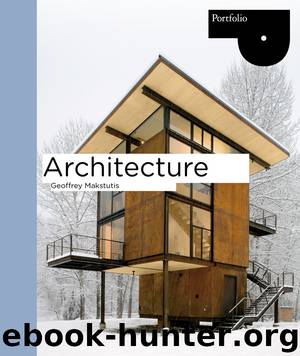Architecture by Makstutis Geoffrey;

Author:Makstutis, Geoffrey;
Language: eng
Format: epub
Publisher: Laurence King Publishing
Space Syntax, Victoria Embankment, London, UK
Space Syntax, Aquatic Centre, London, UK
The use of computers can also help to understand the way in which people move and interact with a site or building. The use of computer simulations can allow architects to design with human behavior in mind, thus easing pedestrian congestion across a site or within a building. For practices such as Space Syntax the use of computer simulation has allowed a theory of space use and human behavior to inform their design process.
Computers do not only allow us to see what the project might look like. During the design-development phase, when many pragmatic issues must also be addressed, simulation software allows designers to verify that their proposals will meet safety standards. Through the use of agent-based simulations (in which human behavior is programmed into virtual agents), we are able to study the way people will move through and around buildings. By programming crowd behaviors simulations can determine what may happen in the event of a fire when many people attempt to escape from the building. Similarly, designers may use such systems to explore the manner in which numbers of people may use an elevator, lobby, or public space.
As we have discussed, the aim of the outline-design or design-development phase is to move the project from initial design ideas toward a more fixed state, so that further detailed development can take place. It is also the aim to ensure that the project is meeting the needs of the client as it progresses. By integrating the work of other consultants—engineers, quantity surveyors, other designers—the architect is able to ensure that the design of the project is moving toward a more realizable state.
Through meetings with client and consultants the architect will have defined the parameters of the project and reached a point at which the design is agreed. It is usual that, at this point, the client will be asked to “sign off” on the design. This means that the client agrees that this is the finalized design, and that it meets their requirements. By literally signing a copy of the drawings, the client agrees (if this has been made clear in the contract) that if any significant changes occur owing to a change requested by the client, then additional time and fees may be charged. The reason for this is that the next phase of the project will start to place specific obligations (both legal and functional) on the project, and any changes will then have potentially dramatic effects on the overall scheme.
This is not to say that there will be no changes. As the project continues to develop there will, inevitably, be minor changes that will be made, either through client requests or by the design team, in order to enhance the project, manage costs and structural requirements, or for any of a number of other reasons. An architectural project is evolutionary—a constant process of development, revision, and evaluation.
Download
This site does not store any files on its server. We only index and link to content provided by other sites. Please contact the content providers to delete copyright contents if any and email us, we'll remove relevant links or contents immediately.
Kathy Andrews Collection by Kathy Andrews(11344)
The remains of the day by Kazuo Ishiguro(8419)
Paper Towns by Green John(4812)
Spare by Prince Harry The Duke of Sussex(4806)
Industrial Automation from Scratch: A hands-on guide to using sensors, actuators, PLCs, HMIs, and SCADA to automate industrial processes by Olushola Akande(4633)
The Body: A Guide for Occupants by Bill Bryson(4600)
Machine Learning at Scale with H2O by Gregory Keys | David Whiting(3668)
Be in a Treehouse by Pete Nelson(3654)
Harry Potter and the Goblet Of Fire by J.K. Rowling(3620)
Never by Ken Follett(3550)
Goodbye Paradise(3463)
The Remains of the Day by Kazuo Ishiguro(3148)
Into Thin Air by Jon Krakauer(3135)
The Cellar by Natasha Preston(3081)
The Genius of Japanese Carpentry by Azby Brown(3045)
Fairy Tale by Stephen King(2976)
120 Days of Sodom by Marquis de Sade(2947)
Drawing Shortcuts: Developing Quick Drawing Skills Using Today's Technology by Leggitt Jim(2943)
The Man Who Died Twice by Richard Osman(2824)
